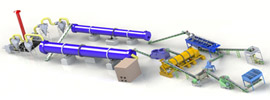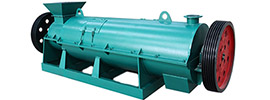Extrusion granulation and wet granulation are two common production processes for organic fertilizers, differing significantly in raw material handling, energy consumption, particle characteristics, and application scenarios. The advantages of extrusion granulation over wet granulation are primarily reflected in the following aspects:
1. Simpler Process Flow and Lower Energy Consumption
- Extrusion Granulation: Particles are formed by mechanically compressing dry or semi-dry raw materials under high pressure, requiring minimal water. The process typically involves raw material mixing, extrusion molding, and cooling/screening, eliminating energy-intensive steps like dehydration and drying.
- Wet Granulation: Raw materials are mixed with water or binders to form a slurry, which is then rolled into spheres using a pan or drum granulator. Subsequent high-temperature drying is required to remove moisture, resulting in higher energy consumption and wastewater treatment needs.
Advantage: Extrusion granulation significantly reduces energy use, making it ideal for regions with high electricity costs or limited water resources.
2. Broader Raw Material Adaptability Without Chemical Binders
- Extrusion Granulation: Relies on the fibrous structure and friction of raw materials for molding, with low moisture requirements (typically 10–20%) and no need for chemical binders. It is suitable for fibrous or low-adhesion materials like straw, livestock manure, medicinal residues, and distiller’s grains.
- Wet Granulation: Requires raw materials to have inherent adhesiveness or the addition of binders (e.g., bentonite, starch) to maintain particle integrity, risking loose or weak granules otherwise.
Advantage: Extrusion granulation accommodates a wider range of raw materials while avoiding potential soil contamination from chemical additives.
3. Higher Particle Density for Enhanced Storage and Transportation
- Extrusion Granulation: High-pressure compression produces dense particles (1.2–1.5 g/cm³) with a compact structure, resistant to moisture absorption and caking during storage and transport.
- Wet Granulation: Particles have lower density (0.8–1.2 g/cm³) and higher porosity, making them prone to softening and degradation in humid conditions.
Advantage: Extrusion granules are better suited for long-distance transport and prolonged storage, minimizing losses.
4. Lower Production Costs and Simpler Equipment Maintenance
- Extrusion Granulation: Features simple machinery (e.g., roller extruders, flat-die presses) with a small footprint and low investment. The absence of a drying stage reduces equipment wear and maintenance costs.
- Wet Granulation: Requires costly drying equipment (e.g., rotary dryers) and faces higher corrosion risks in wet environments, increasing maintenance expenses.
Advantage: Extrusion granulation is cost-effective for small-to-medium-scale production, with a shorter return on investment.
5. Environmental Benefits: Zero Wastewater Discharge
- Extrusion Granulation: Generates no wastewater, aligning with stringent environmental regulations, particularly in water-sensitive regions.
- Wet Granulation: Produces wastewater that requires treatment to prevent secondary pollution.
Advantage: Extrusion granulation supports sustainable production practices by eliminating water pollution risks.
6. Adjustable Particle Strength for Diverse Applications
- Extrusion Granulation: Particle size (1–10 mm) and hardness can be customized by adjusting pressure, die hole diameter, and other parameters, catering to different crops and fertilization methods (e.g., mechanized sowing).
- Wet Granulation: Particle size is limited by granulator speed and binder properties, offering less flexibility.
Advantage: Extrusion granules are more versatile for automated farming systems.
7. Better Nutrient Preservation
- Extrusion Granulation: Low-temperature, high-pressure processing minimizes organic matter decomposition, retaining more nutrients (e.g., N, P, K) and beneficial microorganisms.
- Wet Granulation: High-temperature drying may degrade heat-sensitive nutrients and microbial activity.
Advantage: Extrusion granulation ensures longer-lasting fertility and superior soil improvement effects.
Comparative Application Scenarios
| Scenario |
Extrusion Granulation Advantages |
Wet Granulation Suitability |
| Low raw material moisture |
Processes dry materials directly without dehydration |
Requires adhesive raw materials or binders |
| Limited power/water resources |
No drying needed, saving energy and water |
Best for regions with abundant electricity/water |
| Long-term storage/transport |
High-density particles resist degradation |
Suited for short-term use or local distribution |
| Strict environmental rules |
No wastewater discharge, meeting green production standards |
Requires wastewater treatment infrastructure |
Conclusion
Extrusion granulation organic fertilizer offers distinct advantages in process simplicity, energy efficiency, raw material flexibility, particle quality, environmental compliance, and cost-effectiveness, particularly for small-to-medium-scale operations, diverse raw materials, or eco-conscious markets. Wet granulation remains preferable for large-scale continuous production with high-adhesion raw materials and ample utility resources. Enterprises should select the appropriate method based on factors like raw material characteristics, capital capacity, and regulatory requirements.
 Send us a Email
Send us a Email Wulong Industrial Cluster
Wulong Industrial Cluster Have any question?
Have any question?



















